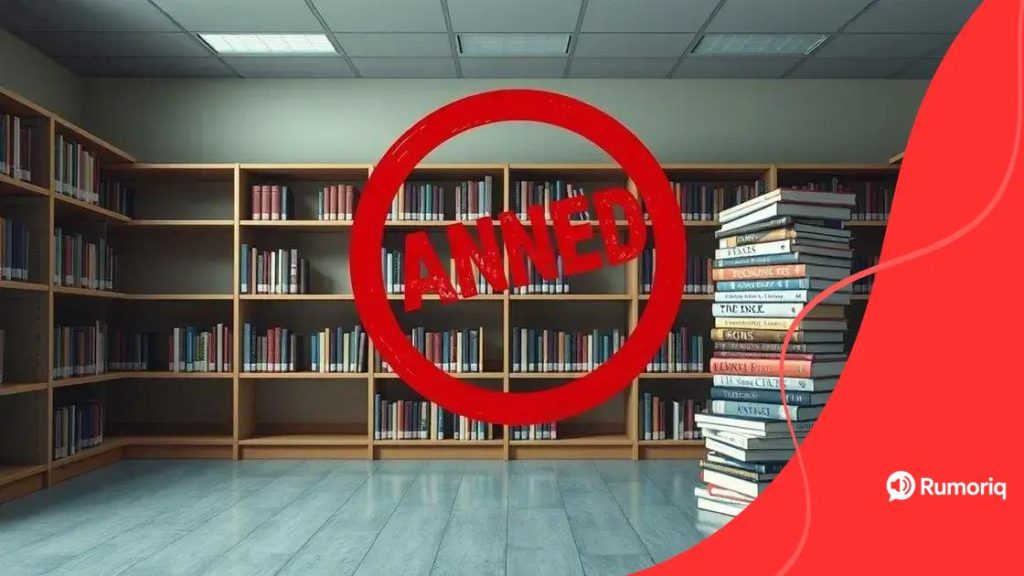Impact of book bans 2025: what are the consequences?

Anúncios
The impact of book bans in 2025 includes stifling critical thinking, limiting students’ exposure to diverse perspectives, and hindering educational growth, while embracing alternatives like curriculum diversity can promote open dialogue and inclusivity.
Impact of book bans 2025 is a pressing issue that influences the education landscape. As schools face increasing pressures to limit access to certain materials, one must consider how these decisions shape our understanding of freedom and knowledge. Let’s dive deeper into the implications.
Anúncios
Understanding the rationale behind book bans
Understanding the reason behind book bans is crucial in today’s society. Many educators, parents, and policymakers grapple with the impact of restricting access to certain texts. It’s essential to explore the motivations and effects of these decisions to foster a better understanding of freedom in education.
Reasons for Book Bans
There are several reasons why books may be banned in schools or libraries. Moral concerns often top the list, with some arguing that certain content is inappropriate for children. Additionally, political pressures can lead to the removal of books that challenge prevailing views.
- Concerns over sexual content
- Portrayal of violence or drug use
- Religious objections
- Political or ideological opposition
This ban can stem from individual or community beliefs that prioritize specific values over others. Furthermore, the influence of advocacy groups may drive parents and administrators to take action against certain titles.
Anúncios
Psychological and Social Factors
The psychological implications of banning books are significant. When students are denied access to diverse perspectives, it can limit their ability to think critically and empathize with others. Exposure to a broad range of ideas encourages critical thinking and helps young readers develop their own beliefs. In this way, book bans can stifle intellectual growth.
Additionally, social dynamics play a role. Some books may be viewed as controversial, sparking discussions and debates among students. These conversations are valuable, promoting dialogue and understanding. When students engage with challenging material, they learn to navigate complex issues in a supportive environment.
Thus, while the rationale behind book bans may seem straightforward, the implications spread further than one might think. Understanding these motivations helps individuals appreciate the value of diverse literature and the potential consequences of restricting access.
The effects of book bans on students and education
The effects of book bans on students and education are profound and far-reaching. When books are removed from libraries or classrooms, students miss out on valuable learning opportunities. Each banned book often tells a unique story that can broaden horizons and enhance critical thinking.
Impacts on Critical Thinking
Students learn to think critically when they are exposed to various perspectives. Book bans limit this exposure, leaving students with fewer viewpoints to consider. When faced with different ideas, they can analyze, question, and build their own beliefs. Thus, banning books can hinder the development of essential skills required for informed citizenship.
- Reduction in exposure to critical social issues
- Limited understanding of diverse cultures
- Fewer opportunities for personal growth
The absence of certain books can silence voices that are essential for understanding the complexities of society. Education thrives on dialogue, and when books are banned, the discussions around them fade as well, leading to an echo chamber of thought.
Emotional and Social Consequences
Moreover, book bans can have emotional effects on students. Kids often seek out characters or topics that resonate with their experiences. When these stories are removed, students may feel alienated or misunderstood. Literature can serve as a mirror for them to see themselves and their struggles, contributing positively to their mental health.
Additionally, social dynamics can be affected. Group discussions about challenging topics often foster a sense of community. However, with book bans, opportunities for bonding over shared experiences decline. Students may miss out on learning empathy and understanding through reading about lives different from theirs.
As we analyze the consequences of these bans, it’s clear that the educational landscape is impacted significantly. When students lack access to diverse ideas, their academic and personal growth is impeded, highlighting the importance of keeping literature open and accessible.
Exploring historical precedents of censorship

Exploring the historical precedents of censorship offers valuable insights into today’s debates about book bans. Throughout history, societies have often grappled with the tension between the desire for safety and the need for free access to information.
Historical Instances of Censorship
Many notable instances of censorship have shaped our understanding of free speech. For example, during the McCarthy era in the United States, many authors faced bans and blacklisting due to their political beliefs. This period saw a significant reduction in the availability of various literary works, limiting public discourse.
- The banning of “The Catcher in the Rye” for its themes of rebellion
- Censorship of books questioning societal norms
- Restriction on communist literature during the Cold War
Furthermore, works like George Orwell’s “1984” and Ray Bradbury’s “Fahrenheit 451” have drawn attention to the consequences of censorship. These tales, while fictional, reflect real fears about the control of information and the suppression of dissenting voices.
The Role of Religion and Morality
Religious institutions have also played a significant role in censorship throughout history. Many books have been banned due to their perceived challenge to religious doctrines. In the past, the Catholic Church maintained the Index Librorum Prohibitorum, a list of prohibited books that contradicted church teachings.
This pressure sometimes led to a chilling effect in publishing, where authors hesitated to express certain ideas out of fear of repercussion. The quest for moral correctness often clashes with the idea of intellectual freedom, showing that the dynamics of censorship are complex and multifaceted.
As we look at these historical examples, it becomes clear that censorship is not just a contemporary issue. Understanding these past precedents helps illuminate the ongoing struggles for free expression today, reminding us of the necessity of advocating for access to diverse voices.
The role of parents and communities in book bans
The role of parents and communities in book bans is significant and often contentious. Parents are typically the first line of defense when it comes to what materials children are exposed to, and their opinions can heavily influence school policies regarding book availability.
Parent Involvement
Many parents have strong beliefs about the type of content they want their children to encounter. Whether it’s due to concerns about morality, age-appropriateness, or ideological clashes, parents often advocate for certain books to be removed from libraries and classrooms. This advocacy can result in organized efforts to challenge specific books deemed unacceptable.
- Advocacy groups formed by concerned parents
- Petitions to local school boards
- Meetings with educators to discuss content
Their involvement can stem from a place of love and care, but it can also lead to conflicts with educators and librarians who strive to provide diverse and thought-provoking literature. When parents push for bans, it brings to light the broader question of who gets to decide what literature is suitable for children.
Community Influence
Communities also play a critical role in book banning discussions. Public sentiment can sway school boards and library systems to either restrict or support access to various texts. In smaller towns, this can turn into heated debates at school board meetings, where community members express their views on what should be read.
Local culture, beliefs, and values shape these discussions significantly. If a community holds conservative views, there may be more push to ban books that touch on topics such as sexuality or racism. Conversely, more liberal areas may resist such bans, advocating for open access to all literature. This dynamic interaction often creates a tug-of-war effect, with public opinion swinging back and forth.
Ultimately, the involvement of parents and communities brings both challenges and opportunities in the conversation about what literature should be available to students. Finding a balance between protecting children and promoting intellectual freedom is a delicate process that requires understanding and dialogue.
Alternatives to book bans in modern education
Finding alternatives to book bans in modern education is crucial for fostering an inclusive learning environment. While some advocate for the removal of certain texts, there are better approaches to managing content in schools that promote freedom of expression and critical thinking.
Curriculum Diversity
One alternative is to focus on enhancing curriculum diversity. Instead of banning books, educators can include a wider range of materials that cover various perspectives. This practice allows students to engage with different ideas and cultures, helping them develop their own thoughts while respecting others.
- Incorporate books from diverse authors
- Study controversial topics in context
- Encourage discussions about varying viewpoints
Diverse literature challenges students to think critically and encourages empathy. By providing multiple perspectives, schools can help combat the urge to ban books, leading to richer educational experiences.
Parental Involvement
Engaging parents and communities in discussions about reading materials is another effective alternative. Schools can host workshops or forums where parents voice their concerns and collaborate with educators. Dialogue allows for greater understanding and can often mitigate fears associated with certain texts.
Instead of pushing for bans, parents can work together with teachers to identify appropriate ways to address controversial content. For instance, offering parental guidance or creating opt-out options for sensitive books allows parents to maintain control over their child’s reading without censoring the entire student body.
Furthermore, promoting literature as a tool for discussion, rather than fear, can foster a more open-minded community. This approach empowers students to voice their opinions while learning to respect differing views.
Ultimately, exploring these alternatives to book bans promotes a healthier educational environment. By supporting curriculum diversity and embracing parental involvement, schools can nurture critical thinkers who are well-equipped to engage with the complexities of the world.
FAQ – Frequently Asked Questions about Book Bans
What are book bans?
Book bans occur when certain books are removed from schools or libraries due to their content, often due to concerns from parents or communities.
Why do some parents support book bans?
Parents may support book bans to protect their children from materials they find inappropriate or controversial, such as themes related to sexuality, violence, or differing ideologies.
What are alternatives to banning books?
Alternatives include diversifying the curriculum, encouraging open discussions about various texts, and involving parents in conversations about reading materials instead of outright bans.
How do book bans affect students?
Book bans can limit students’ exposure to diverse perspectives, reduce critical thinking opportunities, and prevent them from engaging with important social issues.